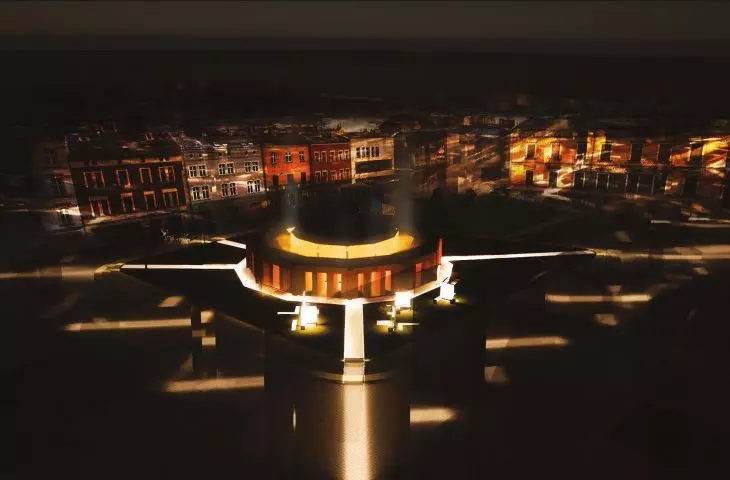New(er) Climate Square—Klimatosfera
proj.: Aleksandra Kotyla, Magdalena Świdnicka (ASP), Weronika Czubaty, Justyna Witkowska (IG UJ), Marcin Dąbrowski (AGH), Sara Faściszewska, Zuzanna Kapciak (IS UJ)
[excerpt from author's description]
According to the devzrost idea, the goal was to change the New Square into a place more friendly to residents, as well as animals. In its renewed appearance, it is intended to serve a recreational function, to be a place of integration and inclusion. As part of all the transformations, the authors applied many environmentally friendly ideas, including renewable energy elements, so that no aesthetic elements would generate additional costs. There are to be many innovative energy solutions within New Square, but also vegetation to support the fight against air pollution. The project also includes retention basins. The solutions being implemented are characteristic of a sustainable city. The Roundhouse has been divided into several zones to serve residents in the spirit of dewzrost. In correlation with the idea of devzrost, consumption functions, i.e. a marketplace, as well as food outlets, have been abandoned. The space inside Okrąglak was named Klimatosfera, as a consequence of the changes made by the authors, it is to be a climate-friendly place that can serve as a workshop room, be a relaxation zone,. In addition, books can be used in this place for bookcrossing. Klimatosfera is a place where zero-waste is followed. It is socially useful, encouraging care for others, ourselves or the environment. In the Kliamatosphere, communal human relationships are to develop, facilitating life despite differences [...].
See the full presentation of the project: board 1, board 2, board 3, board 4, board 5
Symposium_on
proj.: Aleksandra Gierszewska, Dagmara Jędrychowska (ASP), Jan Bytnar (AGH), Ewa Ilczuk, Andrzej Porębski (IS UJ), Kacper Wałęsiak (IG UJ)
[excerpt from author's description]
The essence of the New Square is the potential to bring people together, to serve various groups and various purposes, without compromising the others. A square where people can talk, work, trade and barter, play and relax.
To this end, the authors have proposed a multi-level space that encourages its use in various ways, and at the same time is arranged so that all its functions—those present and those yet unknown—work in full harmony.
The space is designed in such a way that it does not limit the possible uses, but meets the variability of society, its needs and its guiding ideas. Thus, the project is thus aimed at multifunctionality [...].
The New Square together with its central building was conceived as a three-level space:
- SALON—on level -1, is a social communal space, containing catering facilities and a place for entertainment, and allows for events and concerts,
- AGORA—on level 0 is an open and free space, characterized by minimalism and simplicity, it preserves the historical dimension of the square. It functions as a pedestrian thoroughfare, a place for meetings and conversations, as well as a shopping and market space. Simple, hideable structures have been placed on this level, which can function as benches and stalls, among other things. It is suitable for outdoor events.
- GLASSROOM—is a floor inspired by the shape of Okrąglak, providing a zone for rest, peace, conversation, reflection. Full of greenery, with a glass structure isolating the noise from below. It provides an opportunity to break free from the bustle and high pace of the lower levels. Accessible to all—thanks to a spacious elevator.
See the full presentation of the project: board 1, board 2, board 3, board 4
Synergy
proj.: Joanna Jaros, Anna Prokopenko (ASP), Wiktor Ostrowski (IG UJ), Agnieszka Puzio (AGH), Daniel Talajczyk (IS UJ)
[excerpt from author's description]
It is a futuristic design of the New Square called Synergy, which, in the design concept, allows human and non-human energies to be combined and amplified. It allows the current value system based on constant growth, consumerism and individualism to change in favor of moderation and community. Sustainable development implies energy independence of the square. Energy would be drawn from the people for whom the place would serve—the authors have used technology that makes it possible to create electricity with human steps. Special sidewalks, will generate energy, which will be used to power the New Square.
Increasingly intense anomalies and weather phenomena have also affected the project. Water from precipitation is being collected into a retention basin located under the square and used to water the numerous nearby vegetation.
By creating a new, light-colored substrate, the albedo will be reduced, thus avoiding excessive heating of the surface during summer periods. A new social reality has also been proposed, building on the commercial traditions of the New Square, expanding its purpose to include non-financial exchange. According to the project authors' assumptions, the New Square, in addition to a market space , can become a center for the exchange of ideas, views, discussions, as well as an oasis of tranquility amidst the hustle and bustle of the city. Communitarianism is the basic definition of what a degrowth society could look like. It is planned to create gardens on the surface of the square and an accessible space under the square—these places will enable communal action.
See full presentation of the project: board 1, board 2, board 3, board 4, board 5
continued projects on next page






















































































